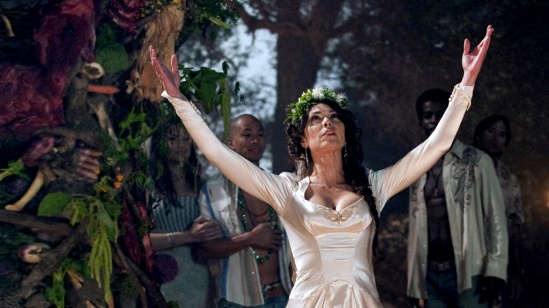Alright, I’m wrapping up my adaptations of deities left behind in 4E. St. Cuthbert and Wee Jas have been handled, and that leaves my favorite of the three, Olidammara.
In 3E, Olidammara, was the go-to deity for rogues of the less-than-good-natured variety. However, similarly to Wee Jas, he ended up encompassing many different things to make him the ultra-rogue. Just check out this passage under “Dogma” in Deities and Demigods:
Olidammara loves upsetting anyone who seems too attached to an ordered life and a predictable routine. He urges his followers to bend every effort toward mastering the art of music. He also teaches that life is meant to be happy and entertaining, and the best jokes need a target to hang them on. The tables can turn on any trickster, and Olidammara’s followers should accept the laugh and appreciate the trick when it happens to them. Wine, Olidammara says, is one of the joys of life, and the only thing better than making wine is drinking it. Avoid misery, temperance, and solemnity, for they are the greatest poisons to the soul. (88)
Boil this down, and you get that he is one hell of a hedon.

Or, if you go by this picture, a medieval hipster: “I was singing ballads before it was cool. What kind? Oh, they’re too indie for you to have heard of.”
Mythology is filled with hedonistic gods.
In Egyptian mythology, the fertility goddess Hathor grew so angry at mankind, she transformed into Sekhmet, a bloodthirsty war goddess. They only way she could be placated was with festivals of wine, which was said to calm her and transform her back into the beneficent Hathor.
Siduri, a goddess likened unto the stereotypical tavern wench appears in the epic of Gilgamesh. She even tells him to abandon his quest for immortality in favor of hedonism. See the Sparknotes version.
Dionysus, though, is the one most people know the best. The Ancient Greek god of wine and fertility, has long been associated hedonism. His worship gave birth to theater in the Great Dionysia in Athens. And his Roman counterpart, Bacchus, gives us the word bacchanalia, which is often used for celebration. His followers, called maenads, were known to worship him by having drunken orgies where they would feast of the raw flesh of small animals, and anyone foolish enough to come across them while they where so wasted, such as in Euripedes’ play The Bacchae.
In the ancient play, Dionysus punished King Pentheus and his mother Agauë for not worshiping him. Agauë is a member of the banchantes, a version of the maenad, and she and her friends go out worshiping one night. After sending Pentheus to spy on the women, Dionysus points him out tho the reveler, and they then proceed to tear him limb form limb and eat him.
Then of course, throwing in a pop culture example, the Maenad Maryann Forrester shows up in Bom Temps, LA in True Blood‘s second season, inciting ritualistic orgies and death.
So this brief tangent was to point out hedonism is not always fun and games.
But also to show that a lot of deities associated with hedonism have some major connection to females, which I think is really limiting for such deities.
While in the previous two cases, I’ve followed the story lines somewhat closely–a vengeful warrior with Boudica and keeping Wee Jas almost intact–I’m think sure a religion needs to break from tradition.
Sex, pleasure, intoxication, and all that is not just the realm of one sex or the other, so this deity will be sexless.
That’s right. Sexless. At least in terms of it being male or female.
Most of these human deities I’ve pictured being worshiped by a vast range of races genetically related to human. In this case, the changeling race fits perfectly for this deity: a deity that can change shape, size, gender, race, and any number of physical attributes to match whatever a worshiper would find most sexually attractive.
No one knows the true name of this deity, but it is often referenced by the names The Lover, The Wine-drinker, The Pleasurer, The Divine Whore, The Dancer in Firelight, and The Great Revelry.
In more mainstream worship, this deity is seen as a fertility deity. Barren women come to the temples seeking aid for childbirth, farmers seek the deity’s blessings for a good crop.
However, all of these people know the other side of this deity’s worship.
More devout worshipers perform rites that involve wine, sex, drugs, food, and anything that can cause pleasure, even some darker things with evil practitioners.
Priests and priestesses operate brothels in the temples for worship and tithes, as well as annual rites near important agricultural periods. Sexuality is fluid and unfixed. Pleasure is king.
Think Caligula, and you might get a pretty good idea.
So this deity has less to do with rogues and more to do with sex, drugs, and rock ‘n’ roll, which is exactly what I’m wanting here.
Now, to make up for missing the post last week, enjoy this awesome song that fits today’s topic.


Pingback: Into the Wild, Blue Pantheon | The Bloodrift Canticles
Pingback: Be good to your goddess | The Bloodrift Canticles
Pingback: … excepting Lover’s Tryst | The Bloodrift Canticles